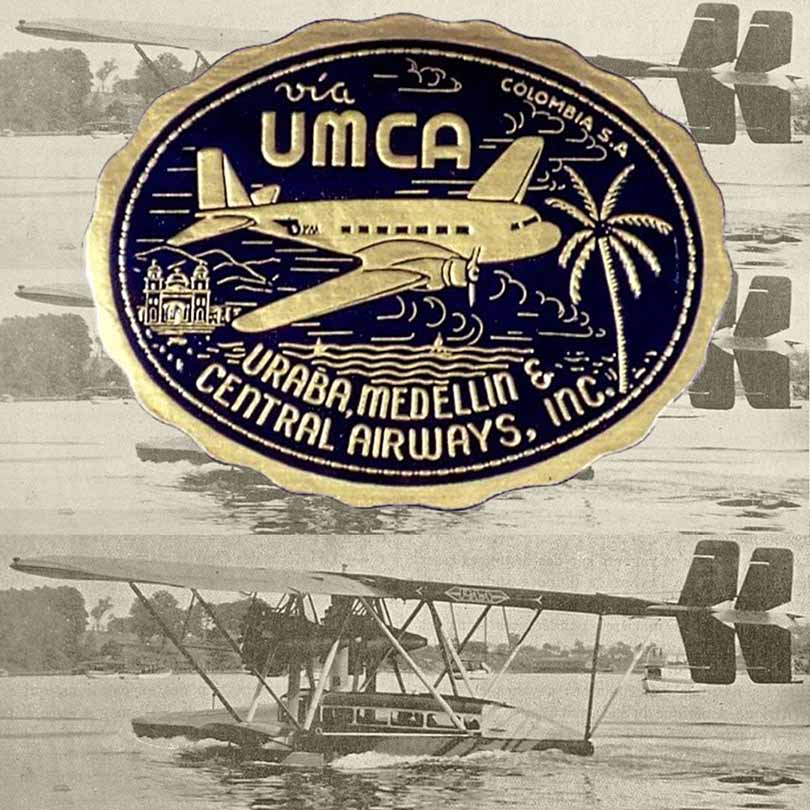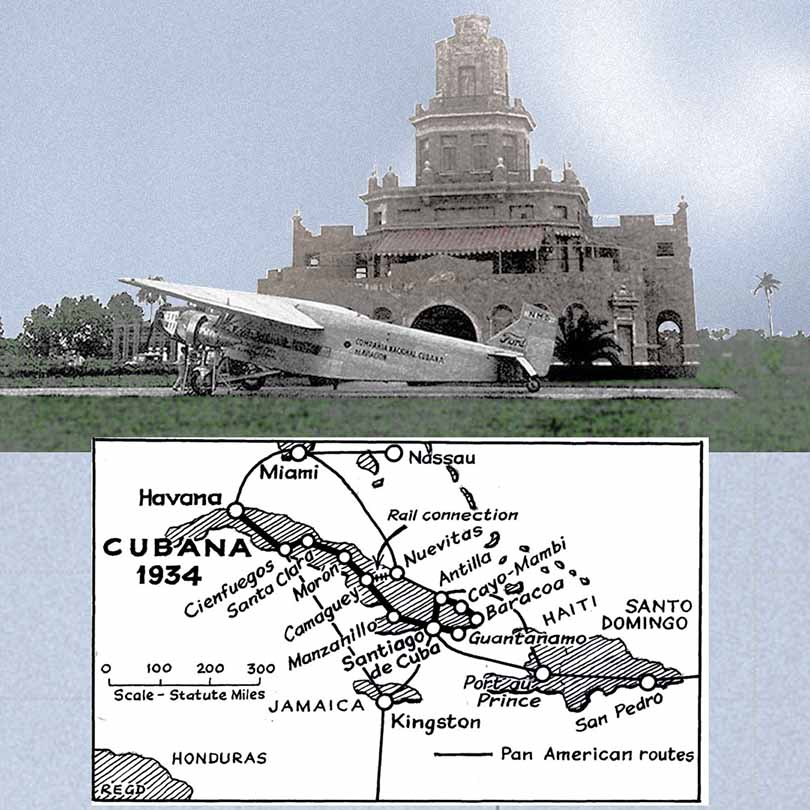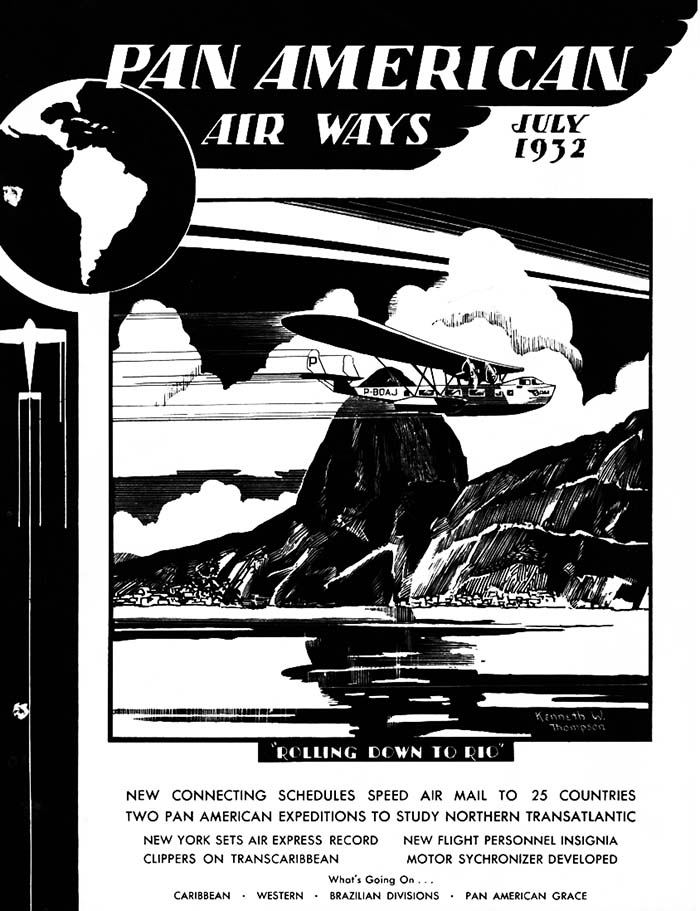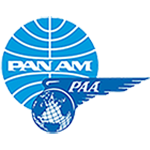PAN AM - 1932
By Eric Hobson
MAY 1932

“Pan Am Buys Colombia’s Paper Airline”

Photo compilation (top to bottom): 1) “Etiqueta utilizada en los equipajes de UMCA” (Tag used on UMCA baggage” by Mauricio Umana. The tag reads: Via UMCA Colombia S.A. Uraba Medellin and Central Airways, Inc. and has an illustration of a DC-2 in flight Date 1934. 2).Sikorsky S-38 of Pan American Airways. Photo from L'Aéronautique Magazine, March, 1929. National Library of France. https://commons.wikimedia.org
Among Aviation Corporation of the Americas (Pan American Airways’ holding company) 1932 purchases, Colombia’s UMCA (Urabá, Medellin, and Central Airways) was the outlier.
Others added assets like aircraft, airports, maintenance facilities, employees, service routes, and contracts to Pan Am’s portfolio. But UMCA’s single contribution was clearance to fly from Colombia’s capital, Medellin, north to Caribbean port city, Turbo, a 200 mile run.
UMCA’s concession came with a caveat: a North American transport company had to provide unimpeded, next-stage, international transport, a proviso Pan Am fulfilled by promising twice-weekly service (Cristobal, Panama to Porto to Medellin) beginning July, 12, 1932 using a Pan Am Sikorsky S-38 (NC145M) renamed, Marichu. After an eleven-month proving period, Colombia awarded UMCA a $1 (US) per pound mail contract, effective June 20, 1933.
Why did Pan Am help UMCA’s founder, Gonzalo Mejia, incorporate UMCA in Delaware on August 24,1931, then eight months later announce a 54% majority stake in what aviation historian, R.E.G. Davies labeled, “a strange little airline”? According to Davies, “It was simply a device to permit Pan American to make a connection with Columbia at a key point (Medellin was right in the middle of the domestic route network);” and, UMCA’s “comparative obscurity was no doubt directly related to its strategic location relating to the Panama Canal and the special political circumstances surrounding diplomatic relations between the United States and Columbia, ever sensitive to past indignities.”
A dictionary definition of “paper airline,” Pan Am personnel and aircraft flew UMCA’s one route for thirty-years (1931-1961).

“Another Month, Another Acquisition”

Photo composite: Cubana Ford at Rancho Boyeros Airport Havana, early 1930s and map of routes by R.E.G. Davies (PAHF Collection).
Pan American Airways 1932 buying spree grabbed Cuba’s only airline, Compañía Nacional Cubana de Aviación Curtiss, S.A. (Cubana) on May 6. A domestic service, Cubana did not compete with Pan Am; each airline fed passengers to the other.
Curtiss-Wright Corporation founded Cubana October 30, 1929, using small, Curtiss aircraft (Robin C1s & Thrushes). As 1929’s financial collapse roiled the industry, “Juan Trippe bided his time, and when the Curtiss-Keys-North American empire got into difficulties, Pan American bought the company.” The $500,000 deal (~ $10.5 million in 2022 USD) netted Pan Am 100% of CNCAC stock, its Cuban domestic airmail contracts and service routes to fourteen cities, as well as material resources and employees. (R.E.G. Davies, Airlines of Latin America since 1919; Smithsonian, 1983)
Renamed, Compañía Nacional Cubana de Aviación, S.A., Pan Am welcomed pilots A.L. McCollough and George Rumill, and upgraded its fleet. On acquisition, Pan Am bought three Eastern Air Transport Ford Model 4-AT-Es (NC 8401, NC 8407 & NC 8408) for Cubana’s use and initiated runway, terminal, and passenger service/accommodation construction projects to merge it into Pan Am’s Caribbean route structure.
Signaling its importance among Pan Am affiliate airlines, Cubana received new aircraft earlier than many: Lockheed Electra L 10-As in January 1935, DC-3s after World War II, DC-4s in 1948, and, in 1953, Lockheed Constellations.
Following World War II, Pan Am began selling Cubana stock, beginning an eleven-year divestment culminating on July 23, 1954. The Cuban government took over Cubana in May 1959.
Photo: PAHF Collection. 1934 Cubana Route Map by REG Davies

“Big Birds On the Miami-Buenos Aires Flyway”

Photo: Cover of “Pan American Air Ways”, July 15, 1932, from the Pan Am Historical Foundation collection.
Concept illustration, “Rolling Down to Rio” by Kenneth W. Thompson, shows a Pan Am-Panair do Brasil Commodore over Rio.
Following September 15, 1930’s takeover of New York, Rio, and Buenos Aires Line (NYRBA), Pan American Airways upgraded infrastructure on the 7,398 mile Miami-Rio de Janeiro-Buenos Aires route. Still, more work was needed because profitability depended on revenue beyond airmail concessions. Continuity clauses required near-to-perfect on-time delivery, making even multiyear U.S. Postal Service contracts tenuous. Passenger and freight loads had grown since October 1930, but passenger comfort and freight capacity still had to improve, at the same time that operation costs had to shrink.
In response, on May 19, 1932, Pan Am replaced its Ford 4-AT-E, Sikorsky S-38, and Sikorsky S-40 route workhorses with 10 of its 14 large Consolidated Commodores that were capable of carrying 22 passengers.
Passengers now boarded a Commodore in Miami and stayed with it and crew for the 4-day, 3,759-mile flight to Para, Brazil where they boarded a Panair do Brasil Commodore for the 4-1/2 day, 3,639-mile Para-to-Buenos Aires run. Fortunately, favorable prevailing winds cut one day off the northbound return.
Emphasizing passenger gains, “Pan American Air Ways” (Vol.3, No.3) noted,
“Changes in schedule … eliminate the day’s waiting time in Miami … The flight now starts two hours later … after the morning trains have arrived. An immediate train-to-plane transfer is made possible by this arrangement. Flying time to Para has been increased from three days to four, providing shorter flying days with more time for rest and sightseeing along the way. Night stopovers are now made at Port au Prince, Haiti; St. Johns, Antigua; and Georgetown, British Guiana.”
Equipment changes improved the route’s operational economics. Passenger, mail and freight capacity doubled on the route’s northern half. Although Pan Am’s change in aircraft did not affect engine maintenance that much, uniform docking and servicing processes increased efficiency along the route.

“Fashion, Feathers, and Film: Air Express Takes Off”

Photos: Loading Pan Am Commodore with record Air Express shipment (l) /shipping baby chicks (r), from "Pan American Air Ways", Vol 3, No. 3, July 1932. Digitized at University of Miami Special Collections.
Although neighborhood delivery vans carry larger loads today, international air freight was novel in 1932 … so much so that “Pan American Air Ways” led its July 15 issue (Vol.3, No.3) with a piece dangling before its readers, “a gold medal which took the air to Bogota, and a chiffon dress rushed to a waiting maiden in Barranquilla,” to tantalize them with what was “beneath the string and wrapping paper” of southbound shipments.
In May 1932 Pan American Airways System’s New York office generated
509 pounds of Air Express shipments (a 64 lb. & 8 customer increase from April), a record that was cheered across the company.
Miami’s May 22 Air Express alone, carried 13 units, valued at $5500 ($115,421 in 2020USD), weighing 257 lbs.
A description of Pan Am's cargo at that time:
“There in the corner in an apartment house of their own, a family of baby chicks on the way across the sky to Jamaica. That burlap covered package contains strawberry plants, carefully sodded, on their way to far-off Santos. Boxes filled with dresses being rushed by a smart Fifth Avenue shop to fair señoritas on the southern continent who want their fashions as new as they are in New York. Right alongside may be gear wheel replacements, serum upon whose speedy, safe delivery lives depend, samples of cosmetics from a New Jersey manufacturer, hatching eggs from a famous Mexican poultry farm, newsreels showing the latest pictures of the political convention in Chicago.”
The piece closed with a declaration that has not changed for over 90 years: “Business, these days, demands speed.” The air freight market grew, and within the year, Pan Am aircraft began flying freight-only charters for deep-pocketed companies and individuals.

